9 Key DevOps Principles: Practices Your Team Needs to Adopt
DevOps is a set of principles that Development and Operations teams implement to deliver high-quality software in record time.
In Agile, Dev and Ops teams worked separately in silos, which negatively impacted the organization’s overall productivity. DevOps solves that problem by uniting Development and Operations into one group tasked with working together to achieve common objectives.
In this article, learn nine crucial Devops principles and practices and how implementing them can help your organization get the most out of DevOps.
What is DevOps?
DevOps is a software development culture that unites development, operations, and quality assurance processes into a continuous set of actions. It facilitates cross-functional communication, end-to-end responsibility, and collaboration, and is a natural extension of the Agile methodology.
Transitioning to DevOps does not require any technical innovation. It depends on adopting the right DevOps principles, values, and adapting them to your organization’s needs.
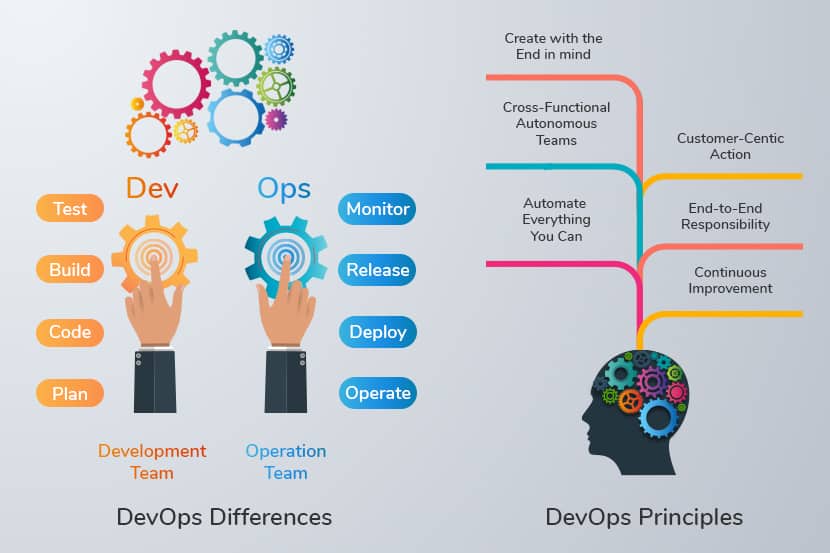
DevOps Principles
DevOps is a mindset or a philosophy that encompasses collaboration, communication, sharing, openness, and a holistic approach to software development.
DevOps relies on a comprehensive set of strategies and methodologies. They ensure the timely delivery of quality software. DevOps principles guide how to organize a DevOps environment.
1. Incremental Releases
Before DevOps, teams had to wait their turn to deploy code. A delay in code release often caused bottlenecks or what is known as “merge hell.” When developers have to wait for a prolonged period of time to contribute code, errors, and incompatibility issues are inevitable.
DevOps encourages developers to contribute new code as often as possible, usually many times during the day. In a DevOps environment, a single project is divided into small, manageable chunks, and teams submit their code in increments. That makes it easier to troubleshoot problematic code before it gets released to production. Depending on the workflow, DevOps teams release code updates and bug fixes on a daily, weekly, or monthly basis.
Incremental releases make the development and deployment cycle more flexible. As a result, teams can quickly respond to sudden changes and fix errors and bugs immediately. The primary goal is to prevent bad code from being deployed to the end-user.
2. Automation
One of the critical practices of DevOps is automating as much of the software development process as possible. Automating workflows allows developers to focus solely on writing code and developing new features.
Anything that can be automated should be automated in a DevOps environment. For example, instead of wasting time on manually checking code for errors, DevOps teams use different software solutions to build and test applications automatically. It is as simple as running a single command to compile the source code to determine if it will work in production.
If the application is written in a language that doesn’t need to be compiled, DevOps teams can run automated tests to check if the new code is production-ready. If there are any errors or bugs in the code, automation will trigger an alert letting developers know which lines of code are causing issues.
Read how Artificial Intelligence is automating IT Operations workflows in our article What is AIOps.
Automation also plays a vital role in dealing with infrastructure management procedures.
In a DevOps environment, teams utilize Infrastructure-as-Code (IaC). Infrastructure-automation software, such as Pulumi, helps manage the provisioning and decommissioning of resources. It involves utilizing scripts, APIs, and CLIs to manage infrastructure as code rather than doing everything manually.
The goal is to enable developers to quickly provision anything from containers and virtual machines to bare metal cloud servers, storage, databases, and other infrastructure.
Infrastructure-as-Code (IaC) made it possible for enterprises to deploy hundreds of servers or applications every day and destroy them when they are not needed. By letting automation take care of infrastructure management procedures, teams can focus their efforts on building and deploying software.
3. DevOps Pipeline
DevOps aims to establish a repeatable system, a loop that facilitates continuity in development. To achieve that, DevOps teams create pipelines.
A pipeline denotes a repeatable system made up of stages through which code has to pass before being deployed to production. A typical DevOps pipeline consists of four primary phases:
- Develop. First, the developers have to write the code.
- Build. Then, the team compiles the code into a build to check for errors.
- Test. After the build phase, operations teams run tests to ensure that the new code will behave as intended in the production environment.
- Deploy. Once the new code has passed the testing phase, it gets deployed to the end-user.
Learn what a DevOps pipeline is and how to create one.
DevOps teams implement critical strategies to achieve a steady flow of code through the pipeline. The most important among them is Continuous Integration (CI) and Continuous Delivery (CD), also known as CI/CD.
Continuous Integration has to do with enabling multiple developers to submit and merge their code regularly, while Continuous Delivery is all about releasing code updates to production as often as possible.
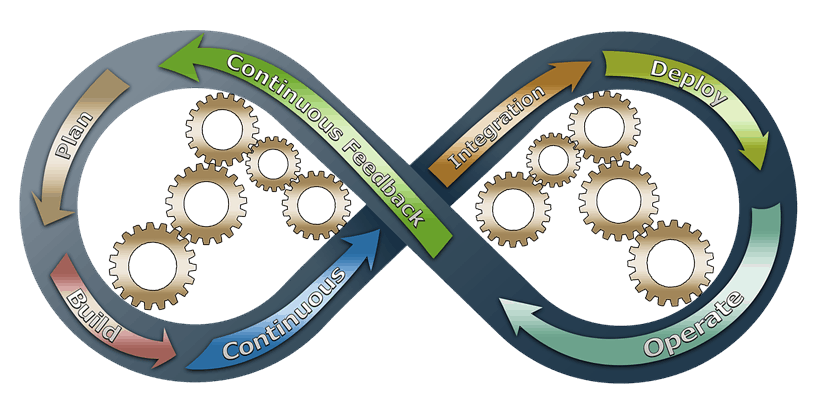
In that regard, “continuous everything” is a DevOps principle that has to do with creating a never-ending development and deployment pipeline.
Along with CI/CD, in professional DevOps environments, teams strive to ensure continuity in every aspect of the pipeline – monitoring, feedback gathering, and deployments.
Learn more about GitOps, the practice of applying DevOps principles of app development to infrastructure management.
4. Continuous Integration
Continuous Integration (CI) plays a pivotal role in a DevOps pipeline. It encourages developers to submit their code to a central code repository multiple times a day.
By integrating smaller chunks of code regularly, the likelihood of bad code moving down the pipeline and causing service interruptions is significantly reduced. Some of the largest organizations that implement DevOps practices commit new code hundreds of times a day.
Another critical aspect of Continuous Integration is automated testing. Before developers commit their code to the master branch, they create builds of the project to determine if the new code is compatible with the existing code. If the build is successful, developers will submit their code to the shared repository. CI relies on a version control system, a central code repository that helps teams track code changes and manage merge requests.
5. Continuous Delivery
Continuous Delivery (CD) is all about releasing code updates frequently and fast. CD relies on developers to manually deploy code to production as opposed to Continuous Deployment, which takes an automated approach to code release. For CD to yield positive results, it’s paramount to create a repeatable system that will push the code through the DevOps pipeline.
Developers working in a CD environment need to keep in mind that their code contributions may get deployed to production at any moment. Having passed all tests and reviews, code updates can be released to production with a click of a button.
Numerous benefits come with continuous delivery. First, it eliminates the risk of downtime and other performance issues because code changes are usually minor. Second, CD enables organizations to release high-quality features much easier, ensuring faster time-to-market, and ultimately eliminating fixed costs associated with the deployment process.
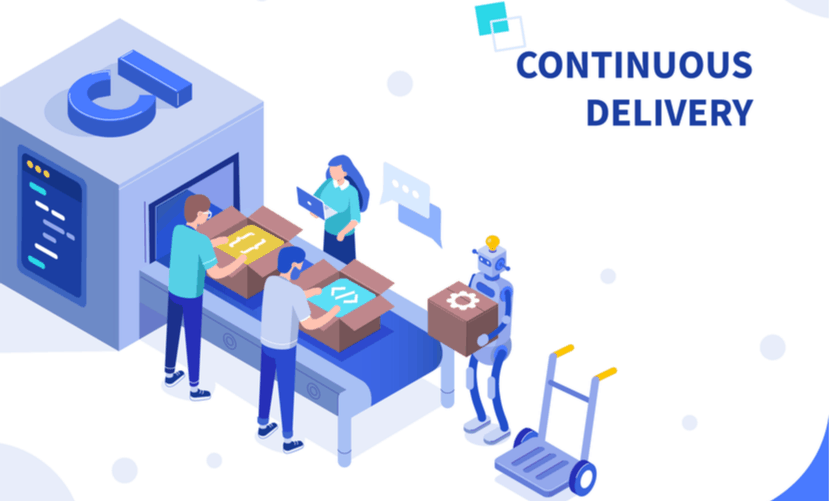
Quality Assurance teams set a committed code test using automation testing tools such as UFT, Ranorex, or Selenium. If QA finds vulnerabilities or bugs, they go back to the engineers. This stage features version control to look for any integration problem in advance. The Version Control System allows developers to record the changes in the files for sharing with other team members, regardless of location.
Codes that pass automated tests get integrated into one shared repository. Several code submissions serve to prevent future drastic differences in code branch and mainline code, lengthening integration. Popular continuous integration tools include GitLab CI, Jenkins, TeamCity, and Bamboo.
DevOps tools help engineers deploy a product in increments, such as Puppet, Chef, Google Cloud Deployment Manager, and Azure Resource Manager.
6. Continuous Monitoring
Continuous Monitoring builds on the concepts of CI/CD, and it ensures the application performs without issues. DevOps teams implement monitoring technologies and techniques to keep track of how the application is behaving.
DevOps teams monitor logs, apps, systems, and infrastructure. Once a problem is detected, DevOps teams can quickly revert the app to a previous state. During that time, the team works on resolving known issues without making the user aware that the code is updated continuously.
Continuous monitoring also helps DevOps teams detect issues that are hindering productivity in the pipeline. After each release cycle, teams should optimize the CI/CD pipeline to eliminate any bottlenecks and ensure a smooth transition of code from one stage to the next.
Peter Borg, SCRUM Master at phoenixNAP, shared his experience on transitioning to DevOps.
7. Feedback Sharing
DevOps thrives on feedback. Developers need actionable information from different sources to help them improve the overall quality of the application. Without feedback, DevOps teams can fall victim to spending time on building products that don’t bring value to stakeholders or customers.
DevOps teams usually gather feedback from stakeholders, end-users, and software-based monitoring technologies before, during, and after the release cycle. They collect feedback through various channels, such as social media and surveys, or by discussing with colleagues.
Teams need to have procedures that will help them sift through the feedback they’ve gathered to extract the most valuable information. Misleading or inaccurate feedback could prove to be detrimental to the entire development process.
8. Version Control
Version control, also known as source control, lies at the heart of every successful DevOps workflow. It helps DevOps teams stay organized, focused, and up to date with what members of the team are doing. Version control is also crucial for ensuring teams collaborate faster and easier to support frequent software releases.
In a nutshell, version control is a central code repository — a place where developers contribute their code and track changes during the development process. Most version control systems allow team members to create branches of the main project. Branches are copies of the project’s source code that individual developers can work on without modifying the original code.
Get started with Git, a popular version control tool, in no time by downloading our free Git Commands Cheat Sheet.
In a typical scenario, each developer works on a separate branch of the same project, submitting code updates and running automated tests. Before the newly written code gets merged with the master branch, automation will create a build of the application that will ensure the new code is compatible with the existing code.
If the build is successful, developers merge the new code with the master branch and deploy it to production or run other tests, depending on the workflow.
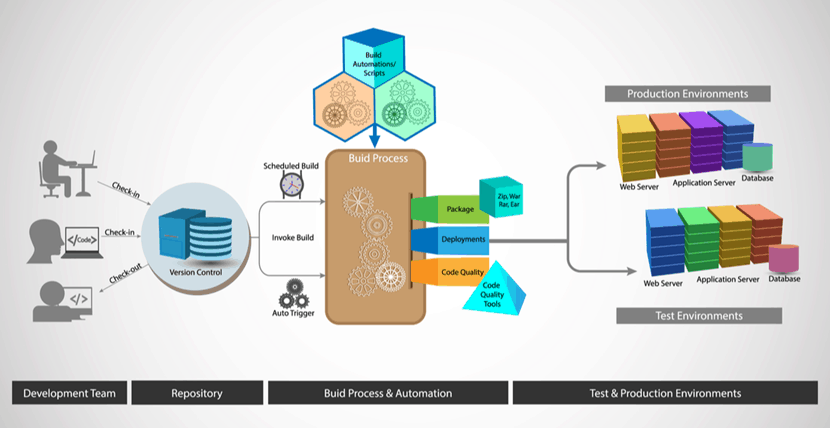
With a robust version control system in place, DevOps teams can be confident that only error-free code is moving down the pipeline and getting deployed to production.
9. Collaboration
The main idea behind DevOps is to establish trust among developers and operations. Dev and Ops teams need to communicate, share feedback, and collaborate throughout the entire development and deployment cycle.
In such a setting, both groups are responsible for ensuring the application delivers on its promises. That requires continuously optimizing and improving the performance, costs, and delivery of services while keeping users satisfied.
Creating this type of inclusive, collaborative environment also involves accepting a cultural shift within the company. To execute DevOps successfully, it’s crucial to have the stakeholders and DevOps teams be on the same page, working together to deliver software solutions that bring real value to the company and its customers. DevOps requires the entire company to behave like a startup, continuously adjusting to market changes, and investing time and resources in features that attract more customers.
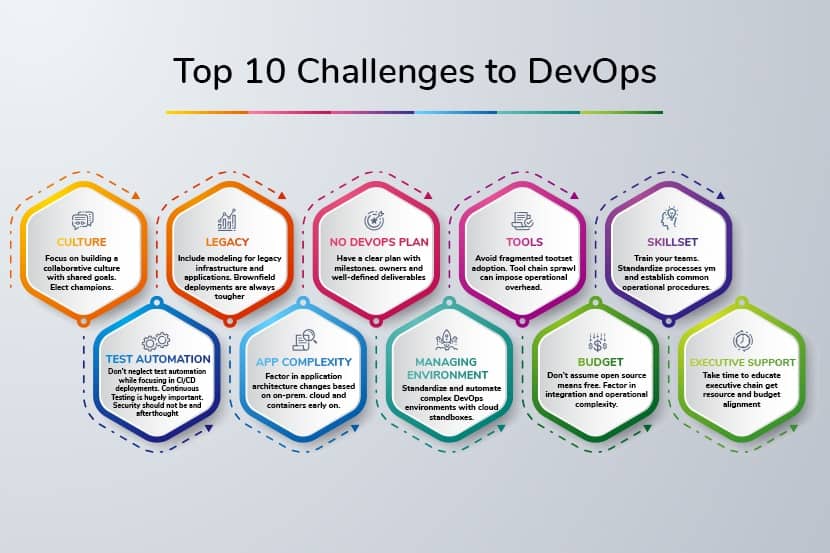
Remember, a Devops Culture Change Requires a Unified Team
DevOps is just another buzzword without the proper implementation of certain principles that sit at the heart of DevOps.
DevOps revolves around specific technologies that help teams get the job done. However, DevOps is, first and foremost, a culture. Building a devops culture requires an organization to work as a unified team, from Development and Operations to stakeholders and management. That is what sets DevOps apart from other development models.
When transitioning to DevOps, remember that these principles are not set in stone. Organizations should implement DevOps methodologies based on their goals, workflows, resources, and the team’s skill set.